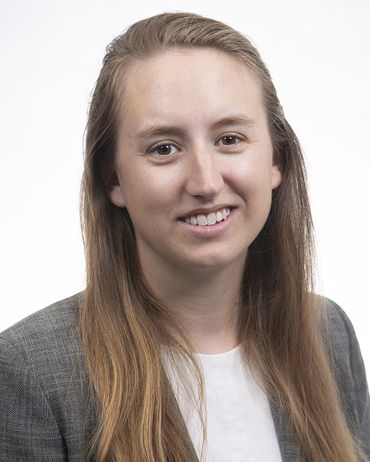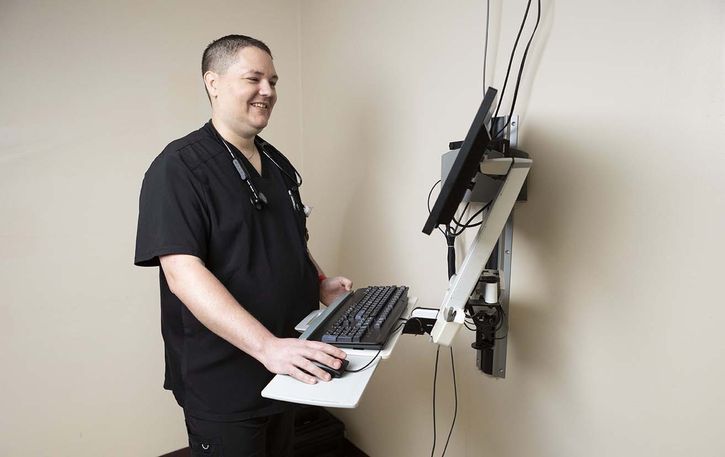It wasn’t the first time that police officer James “Jamey” Kelly felt the pull into a healthcare career, and it wouldn’t be the last.
This time he was the first officer on the scene of a serious car crash in Sedgwick County, Kansas, near Wichita, his hometown. A woman had severe injuries and needed to be taken to a hospital. Paramedics and emergency medical technicians (EMTs) arrived and asked Kelly to ride along in the ambulance. On the way, he began to think again about something that had increasingly been on his mind since he became an officer: “wanting to help people even more.”
“I rode in the ambulance providing assistance by holding pressure and following directions until we arrived at an emergency room,” Kelly said. “That incident showed me how I wanted to continue my education.”
A few years afterward—following up on suggestions from a paramedic and an emergency room nurse—Kelly signed up for EMT certification classes. After completing that training, he eventually decided to officially shift from criminal justice classes at a community college and begin the healthcare coursework that would lead to his career switch from law enforcement officer to certified medical assistant (CMA).
Kelly, 40, now works in the Neurology Clinic at the University Health Lakewood Medical Center in Lee’s Summit, Missouri, near Kansas City. Kelly, who is married and has five children ranging in age from 6 to 17, said that his path might not have been conventional, but it has provided a rewarding career that allows him to financially support his family while filling a longstanding desire to help others.
Kelly and his peers—workers in the fast-growing healthcare field who have “some college” but not bachelor’s degrees or more advanced academic degrees—are part of a workforce segment that has seen notable wage growth since the start of the COVID-19 pandemic. Kansas City Fed Associate Economist Emily Pollard explored the topic in detail in an Economic Bulletin published in December 2023.
Pollard’s study found that, compared with 2019, the overall labor force contains about 1.5 million fewer individuals who have some post-secondary education but less than a bachelor’s degree. As a result, vacancies for jobs that require a post-secondary certificate or an associate degree remain high, especially in health-related fields. These shortages have contributed to higher wages in the healthcare sector, and the scenario is unlikely to change soon.
“First, the vacancies data suggest that while employers have strong demand for workers with this level of education, the supply of these workers is limited,” Pollard said. “Consequently, employers may be forced to offer higher wages in hopes of attracting qualified workers. Second, the employment data suggest that employers have turned to workers with more education to fill these open positions. More highly educated workers are generally more expensive; thus, as employers shift to these workers, the average wage in these occupations is likely to increase.”

Associate Economist Emily Pollard
What the trends tell us
The components central to Pollard’s study—labor tightness and inflation—are among the trends closely monitored by the Federal Reserve.
“Healthcare in general has very high labor costs, and wages in the healthcare sector feed into overall inflation and prices,” Pollard said “It’s something that we want to keep in mind. So, in healthcare, here’s another place where we have labor tightness.”
Pollard found that the increase in wages in the healthcare field from 2019 to 2023 was in line with the increase in wages across the economy during that same period. However, wages for healthcare and for the economy as a whole increased much more during that span than from 2015 to 2019.
“In fact, they grew about twice as much,” Pollard said. “For instance, CPS (Current Population Survey) data show wages in the healthcare field grew about 12% from 2015 to 2019 compared with nearly 25% from 2019 to 2023.”
While studying those trends, Pollard explored the drop in the number of individuals with some college education in the overall workforce compared with pre-pandemic years. She began by asking “Who are these people, and where did they go?” She found that there has been an especially high rate of retirement in that education group while fewer young people with that level of education have been entering the labor force.
Administrators and human resources professionals in the healthcare sector are still dealing with the effects of those trends.
“Healthcare recruitment across the board has reached a new dynamic,” said Danielle Harrison, senior director of talent acquisition for University Health. “Throughout the COVID-19 pandemic, many individuals left the healthcare profession, and many students dropped out of school, or finished school but were underprepared to enter the workforce in the pandemic state.”
While acknowledging the data presented in the Economic Bulletin, Harrison said that a broader picture should be understood.
“I believe other factors have contributed to the overall wage inflation, including the shortage of skilled professionals; the mentality around gig/staffing agency work; and the competition between local hospitals,” Harrison said. “I believe there is fierce competition for all positions in healthcare, regardless of the educational component.”
The post-pandemic competition for workers with “some college” can extend beyond hospital settings.
“In today’s rapidly evolving job market, it is crucial for the public to understand that a college degree does not define one’s capabilities or potential for success,” said Greg Ikner, president of The AGA Group, an Overland Park, Kansas-based staffing and recruiting firm specializing in the dental health workforce. “As we navigate the post-COVID-19 labor market, the demand for skilled healthcare professionals has never been higher.”
Ikner said that following the pandemic he has seen employers increasing compensation offers to workers who hold certifications. He said that it is important for employers in general to understand that—compared with previous eras—these workers might not have four-year degrees, but they have more options.
“Many high school grads are seeking careers that interest them in IT, project management, sales, architecture, plumbing and electrical work,” Ikner said. “These jobs and careers are well-paying, and there is no burden of four-year school loans that eat into your paycheck. By tapping into this talent pool, businesses can benefit from a more diverse and innovative team.”

James "Jamey" Kelly, a former police officer, is a certified medical assistant at University Health's Lakewood campus in Lee's Summit, Missouri.
Inside a career shift
For his part, Kelly said he doesn’t regret the change to a healthcare career despite the fact that he comes from a long line of lawmen on both parents’ sides of the family. Varying family experiences with healthcare set the foundation for the switch, even if he didn’t always realize it. For example, his sister once worked in medical billing, and his mother served as a counselor in a Wichita area health clinic serving low-income patients.
At age 8, Kelly was diagnosed as a Type 1 diabetic, meaning that he had to learn to inject insulin. Later, his mother would invite him to speak to youth groups at the clinic as part of diabetes awareness and outreach efforts. Kelly now wears a continuous glucose monitor to help manage his health, and he freely shares his experiences as a way to enlighten others about the condition. “I tell my story frequently to patients, my co-worker and friends,” he said. Kelly also said that his career decision was heavily influenced by the care provided to his daughter (now 12 years old) when she faced a serious medical condition as an infant. Those interactions with doctors, nurses and staff “changed my mentality,” he said.
When he decided to move on from criminal justice classes, he found a program at Wellspring School of Allied Health in Kansas City that offered two healthcare certifications on an accelerated track.
“I am a CMA through the American Association of Medical Assistants, and I completed certification through the National Association of Health Professionals as a Nationally Certified Registered Medical Assistant,” Kelly said. “The healthcare field offers a lot of positive things: Some of the best medical insurance available, great flexibility and readily available positions worldwide… My options are limitless as a medical assistant.”
Kelly’s duties day to day can range from recording patients’ vital signs and medical histories to coordinating information pertaining to medical records, test results and medication as needed by physicians and pharmacists.
“My education and hands-on schooling gave me confidence to hit the ground running in our hospital,” he said.

Jandel Allen-Davis is president and CEO of Craig Hospital in Englewood, Colorado, and a Kansas City Fed director.
Assessing the outlook
In healthcare occupations as a whole, unwinding of labor tightness does not appear on the horizon, Pollard concluded in her research. The increase in retirements among workers with some college education was part of a long-term trend rather than a pandemic anomaly, so that is unlikely to reverse course. Other data in Pollard’s study suggests that the number of young workers stepping into roles left by those retirees is unlikely to increase substantially in the short term.
“We are an aging population,” Pollard said. “A lot of people went to school 35 or 40 years ago for associate degrees and are now aging out of the workforce.”
Beyond those factors, the healthcare sector overall is having to adjust how it recruits and retains people, according to Jandel Allen-Davis, president and CEO of Craig Hospital in Englewood, Colorado. Allen-Davis also is deputy chair of the Bank’s Kansas City Board of Directors.
“The reality is that we (in healthcare overall) are going to need to rethink how we onboard people,” which goes beyond compensation and extends to such factors as having work environments that are welcoming, inclusive and attentive to language and culture,” Allen-Davis said.
That notion of onboarding can require training and development in “soft skills to effectively navigate workplaces,” she said. “I don’t know that certificate programs or associate degree programs are teaching that, and I’m also not sure that colleges are either. But that’s a big problem, both in terms of retention and engagement.”
She added that wages are part of a much bigger picture that the healthcare sector needs to work through.
“We’re in an era where we’ve got to rethink the whole nature of recruitment and retention and what qualifications for work look like without, in our business, sacrificing safety or quality,” Allen-Davis said. “As you start to see turnover rise, there’s a tendency (among employers) to increase wages just to be able to recruit and keep people without dealing with the root causes of why your turnover is what it is—especially when the job market is as tight as it is.”
At University Health in Kansas City, Harrison said that one of the ways the medical center has addressed those challenges was by establishing Career Pipeline Programs. These programs offer free education and training, and participants are paid while working on site. For example, one of the offerings is a medical assistant apprenticeship in partnership with Metropolitan Community College of Kansas City and the Full Employment Council. Upon completion, participants can transition from apprentice to employee in the University Health system.
“We consider that a win-win scenario,” Harrison said.
